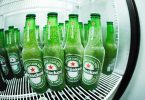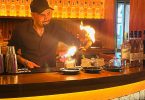Bitters? The Bitter Truth
German bitters brand The Bitter Truth has teamed up with Drumshanbo Gunpowder Irish Gin and to mark the collaboration mixologists and bar owners from Dublin’s top cocktail and bar venues arrived in Zozimus and The Exchequer to attend one of two exclusive bitters masterclasses being given by Alexander Hauck, the German co-founder of The Bitter Truth.
A barman himself until about 10 years ago, he now stays in touch with the bar scene by doing guest shifts from time-to-time.
“We make ‘products for bartenders by bartenders’,” he claims of his Bitter Truth range, now in 60 countries.
With the boom in cocktail culture, bitters have come to the fore over the past 10 or 15 years, he says.
So what are bitters all about?
“Bitters are the spice rack for your bar,” says Alex, “This best explains their use and it’s why we’ve a wooden rack to hold the bottles.
Bitters were originally designed as medicinal products comparable to cough syrups.
The first cocktail bitters (stomach or aromatic bitters) were made by doctors or apothecaries in the early 19th Century when famous brands included Peychaud and Angostura.
“They were developed as a medical support against tropical diseases too,” says Alex, “And many were designed as a ‘panacea’ for all ailments.”
Back then it was not unknown for people to drink a cocktail first thing in the morning to protect themselves against germs and bacteria. They were considered a medicinal drink.
“Later on, they drank them simply for the taste.”
“These are cocktail bitters, not aperitif bitters or digestif bitters,” he explains.
During Prohibition in the US, all cocktail bitters of US origin vanished from the scene, explains Alex, “… and following Prohibition consumers’ tastes had changed considerably. They demanded lighter drinks with less flavour, thus the rise of vodka and alcohol with less taste. For many bitters brands it was hard to survive. Angostura bitters, located in Trinidad and Tobago, was among rum producers and so Angostura went into that business”.
The Bitter Truth brand was developed to bring to life some of the most exhilarating tastes and flavours of the past in a modern context.
Alex invented The Bitter Truth brand with fellow barman Stephan Berg in 2006 following a conversation about how difficult it was to source high quality cocktail bitters in Germany.
Both bartenders had extensive knowledge of the various forms of bitters from their years in the industry and Stephan owned a large collection of current and historical bitters, some of which hadn’t been produced for decades. Because of this he knew how the most well-known bitters in the world tasted and was considered a specialist in this area.
“When we launched the brand we wanted to give people a different option” Alex tells me, “there are different kinds of rum, gins, vodkas and whiskies, but when it comes to bitters there was only Angostura.”
Their first foray into production resulted in orange and aromatic bitters.
“Bitters are not tinctures but are multilayered with 10-30 ingredients and you need to know a bit about bitters, a bit like a chef – which base goes well with which bitters – you kind of know if you’re experienced…. That’s why we do training like this, to show how to use bitters and not to be shy about using them!
You need one or two dashes to have a significant effect on a drink,” he continues, “It’s not enough to just add a few drops. Our bitters make use of the ‘dash’ technique.”
In fact, he advises mixologists to take the cap off the bitters bottles at the beginning of the shift as it’ll save them cocktail-making time and help produce the drinks faster at a busy bar.
“Bitters add complexity and balance out a drink that just consists of a base spirit and a modifier” he says, “Bitters build a bridge between different ingredients, rounding it off.
“By adding different kinds of bitters – we have 11 different ones – you can give the drink a certain twist depending on the bitter, for example you can use fruit bitters or you can use celery bitters which are a bit more savoury.”
Celery is very unusual flavourwise. It became really popular as soon as they launched it.
“It’s the reason we won so many awards.”
Since the company’s inception in 2006, it has won Best New Product at Tales of the Cocktail in 2010 for its Celery Bitters (which also won Best New Product in the Drinks Industry at the Bar Convent in Berlin, a trade show for the cocktail industry there).
And the company has grown its portfolio of products significantly to include the new violet liqueurs bitters for example.
For the Irish launch, Alex developed a series of cocktail recipes featuring the two “super-premium brands” which have now been officially launched in Ireland and are included in ‘Garden and Tonic’ featuring Drunshanbo Gin, The Bitter Truth Elderflower and Celery Bitters with Lemon Juice, Mint and Tonic Water while ‘Aviation’ features Drumshanbo, The Bitter Truth Violet Liqueur, Lazaroni Maraschino Liqueur and Lemon Juice.
Other bitters combinations include ‘Peach Old Fashioned’ comprising Jefferson’s Bourbon Whiskey, The Bitter Truth Peach and Jerry Thomas bitters, plus sugar and orange zest.
‘Puka Beach Cocktail’ sees Diplomatico Mantuano Rum mixed with Bitter Truth Golden Falernum, Orange bitters and lime juice.
Both brands are represented in Ireland by Dalcassian Wines & Spirits.








